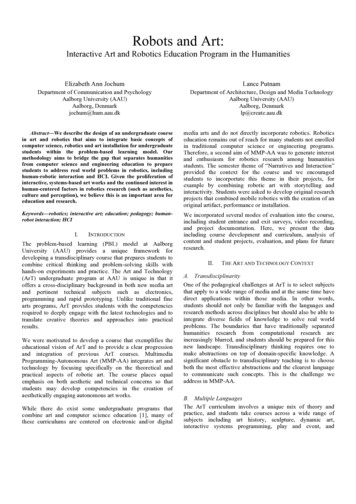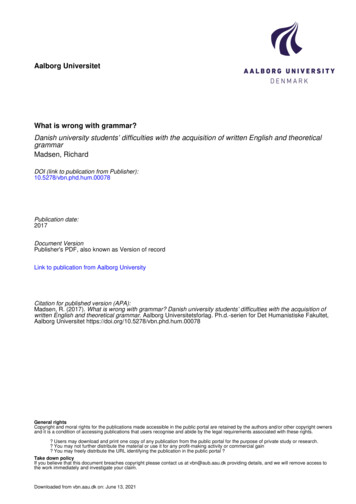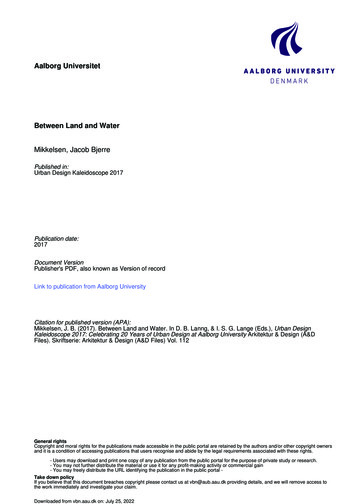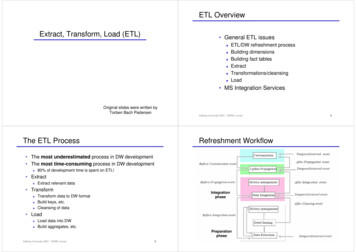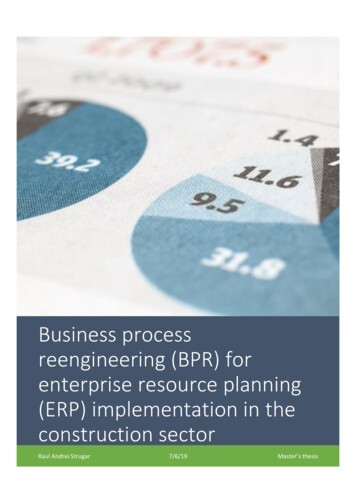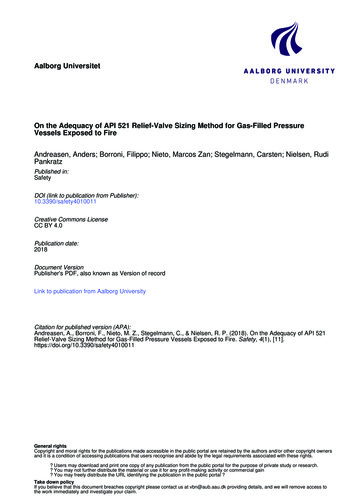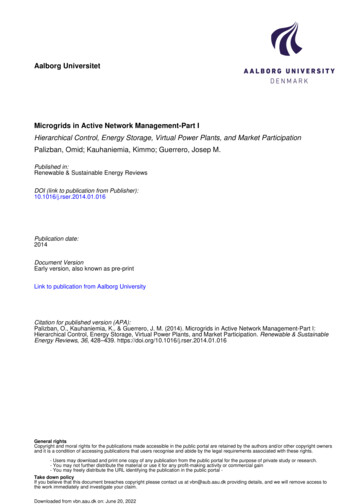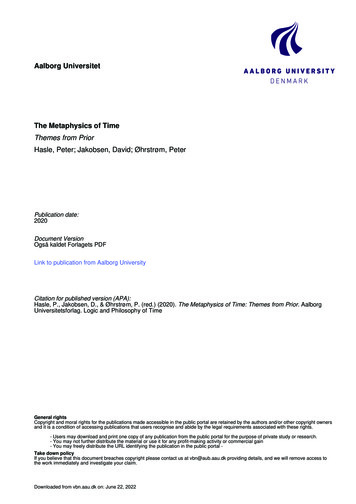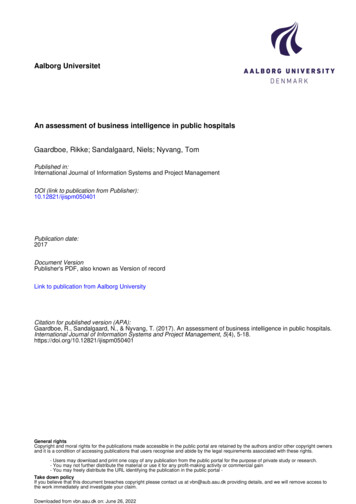
Transcription
Aalborg UniversitetAn assessment of business intelligence in public hospitalsGaardboe, Rikke; Sandalgaard, Niels; Nyvang, TomPublished in:International Journal of Information Systems and Project ManagementDOI (link to publication from Publisher):10.12821/ijispm050401Publication date:2017Document VersionPublisher's PDF, also known as Version of recordLink to publication from Aalborg UniversityCitation for published version (APA):Gaardboe, R., Sandalgaard, N., & Nyvang, T. (2017). An assessment of business intelligence in public hospitals.International Journal of Information Systems and Project Management, 5(4), 5-18.https://doi.org/10.12821/ijispm050401General rightsCopyright and moral rights for the publications made accessible in the public portal are retained by the authors and/or other copyright ownersand it is a condition of accessing publications that users recognise and abide by the legal requirements associated with these rights.- Users may download and print one copy of any publication from the public portal for the purpose of private study or research.- You may not further distribute the material or use it for any profit-making activity or commercial gain- You may freely distribute the URL identifying the publication in the public portal Take down policyIf you believe that this document breaches copyright please contact us at vbn@aub.aau.dk providing details, and we will remove access tothe work immediately and investigate your claim.Downloaded from vbn.aau.dk on: June 26, 2022
ISSN (print):2182-7796, ISSN (online):2182 -7788, ISSN (cd-ro m):2182-780XAvailable online at www.sciencesphere.org/ijispmAn assessment of business intelligence in public hospitalsRikke GaardboeDepartment of Communication and Psychology, Aalborg UniversityRendsburggade 14, 9000 Niels SandalgaardDepartment of Business and Management, Aalborg UniversityFibigerstraede 11, 9220 Aalborg OEDenmarkwww.shortbio.org/nis@business.aau.dkTom NyvangDepartment of Communication and Psychology, Aalborg UniversityRendsburggade 14, 9000 stract:In this paper, DeLone and McLean's information systems success model is empirically tested on 12 public hospitals inDenmark. The study aims to investigate the factors that contribute to business intelligence (BI) success. 1,352 BI endusers answered the questionnaire. A partial least square structural equation model was used to empirically test themodel. We find that system quality is positively and significantly associated with use and user satisfaction, and thatinformation quality is positively and significantly associated with user satisfaction. User satisfaction is positively andsignificantly related to individual impact. The other paths in the model are insignificant. Our findings also provideempirical support for the role of user satisfaction as a mechanism that mediates the relationship between informationquality or system quality and individual impact. User satisfaction is not only a critical construct in the informationsystems success model but it also serves as a mediator. Generally, the model finds empirical support, as it has a good fitand predictive value.Keywords:IS success; evaluation; business intelligence; healthcare information system; quantitative method.DOI: 10.12821/ijispm050401Manuscript received: 28 April 2017Manuscript accepted: 20 November 2017Copyr ight 2017, SciKA. General per missio n t o republ ish in pr int or elect ronic forms, but not for profit , all or part of t his mat er ial is grant ed, provided t hat t heInt ernat ional Jour nal o f I nfor mat io n S yst ems and Pro ject Manage ment copyr ight notice is given and t hat reference made t o t he publicat ion, t o it s dat e of issue, and t ot he fact t hat reprint ing pr ivileges were grant ed by per miss io n o f SciKA - Associat ion for Pro mot ion and D isseminat io n o f Scient ific Knowledge.International Journal of Information Systems and Project Management, Vol. 5, No. 4, 2017, 5-18 5
An assessment of business intelligence in public hospitals1. IntroductionBusiness intelligence and analytics are increasingly important technologies for organizations. In many organizations,Information Technology (IT) managers prioritize investments focused on establishing or operating a technologyinfrastructure that is not only able to handle the increasing volume of data but also make that data accessible to analystsand decision makers [1]. One driver of this development is the desire of many executives to develop data-drivenorganizations [2]. According to Madsen [3], “data-driven” means that “information must be consumable and contextual,to encourage action that will modify behavior over time.”One sector that generates large amounts of data is the healthcare industry owing to its need to meet requirements relatedto patient records, compliance, and patient care [4]. Therefore, use of business intelligence (BI) to data from healthcareinformation systems (HIS) is relevant. BI is an umbrella term that covers the applications, infrastructure, tools, and bestpractices that enable organizations to access and analyze information with the aim of improving and optimizingdecisions and performance [5]. Notably, a study by Parente and Dunbar shows that healthcare organizations that useHIS have higher operating margins and total margins than organizations without HIS [6].Healthcare is one of the most knowledge-driven and complex sectors in the world. In addition, the area represents oneof the most significant economic challenges [7]. As such, BI has the potential to improve the quality, efficiency, andeffectiveness of health services [8]. More specifically, Mettler and Vimarlund [8] suggest that, in the field of healthcare,BI can add value to patient services, marketing management, operational analyses, and personal development, as well asenhance financial strength. These authors also point out that real-time data is essential for improving the quality ofhealthcare services and decreasing the risk for patients. However, implementing and succeeding with BI is acomplicated process [9], and BI technologies are expensive, given the costs associated with software, licenses, training,and wages [10]. Notably, many organizations fail to realize the expected benefits of BI [10–12].In the Scandinavian countries, the majority of hospitals are funded and operated by the public sector. Private hospitalsand privately funded health insurance account for only a small part of the industry. According to the Scandinavianwelfare model, citizens have a fundamental right to proper care and equal treatment. A fundamental principle in thisregard is that all citizens have a right to healthcare regardless of their social background, and healthcare benefits are notlinked to health insurance or other forms of user payment [13]. Notably, however, the Scandinavian healthcare sectorhas been reluctant to use BI in conjunction with its data because of the complexity of such systems and the data itself[3]. However, in Denmark, the public hospitals use BI in combination with HIS, accounting, and payroll systems, andthe users of BI have a variety of job functions (e.g., doctors, nurses, managers, administrative staff). In some cases,users have access to both the source system and BI, while the BI systems must be used to access certain types ofinformation in other cases.A theoretical issue that has dominated the information systems (IS) research for many years is IS success. The literatureoffers numerous definitions and measures of IS success [14]. DeLone and McLean introduced the IS success model,which consists of six constructs: system quality, information quality, user satisfaction, use, individual impact, andorganizational impact [15]-[16]. Like the healthcare sector, the public sector has a significant amount of data and acomplex system landscape [17]. Moreover, there are differences between IS evaluations in private and publicorganizations [18]. Most studies of IS success have been carried out in private organizations [14], while empiricalassessments of IS success are lacking in the public sector [14]/ [19]. Consequently, research on IS success in relation toBI in the healthcare setting is needed and, for this purpose, DeLone and McLean’s model [15] is relevant. In this regard,our goal is to assess business intelligence success in public hospitals in Denmark. In this paper, we extend the paperpresented at the HCIST 2017 conference [2].We test DeLone and McLean’s IS success model on 12 public hospitals and their administrations. The articlecontributes to the subfield of "BI success," especially "BI success in public hospitals." The remainder of the article isorganized as follows. In the next section, we present the IS success model, while we discuss our method in Section 3. InSection 4, we present the results, which are discussed in Section 5. The final section covers our conclusions.International Journal of Information Systems and Project Management, Vol. 5, No. 4, 2017, 5-18 6
An assessment of business intelligence in public hospitals2. Related literature and research model2.1 Business intelligence systemsA wide range of BI systems can be found in organizations [20]. BI can be understood from both technical and businessperspectives [21]. Technical definitions of BI focus on applications, infrastructure, tools, and best practices [5]. In suchcontexts, BI systems are often categorized as: (a) extraction-transformation-load (ETL) systems in which data aretransferred from the transaction systems to the data warehouse; (b) data warehouses (DWs), which are databases forstoring and aggregating data; (c) analytical tools, such as online analytics processing (OLAP), which enable users toaccess, analyze, and share the information stored in DWs; and (d) the presentation layer, which is the user interface[21].The definitions that adopt a business perspective emphasize BI as concepts and methods aimed at improving decisionmaking in the organization [22] and distributing “the right information to the right people at the right time” [23].According to Bach et al. is the importance of BI related to; “ the generation of timely, relevant and easy to useinformation which will have positive impact on making better and faster decisions at different management levels.”[51].Wixom and Watson [24] define BI as “commonly used to describe the technologies, applications, and processes forgathering, storing, accessing, and analyzing data to help users make better decisions.” This definition implies that if BIis utilized to enhance decision making, it can affect the organization's performance.A considerable amount of literature focuses on the value of BI. The general finding is that BI enhances organizationalperformance by accomplishing a goal, such as increasing revenue and productivity, or reducing costs [25]. BI alsocontributes to customer and employee satisfaction. A second discussion in the extant literature centers on theorganizational impact of BI. In this regard, “impact” refers to “a state when organizations have achieved one or more offollowing outcomes: improved operational efficiency of processes; new/improved products or services; and/orstrengthened organizational intelligence and dynamic organizational structure” [25]. Several researchers have shownthat BI can have an impact on transforming business processes [26], minimizing mistargeted customers [26], enhancingorganizational intelligence, and developing products or services [25].In sum, the definition of BI contains technical, organizational, and individual perspectives. The technology makes itpossible for system users to make better decisions. Against this background, behavioral change and, thereby, an impacton organizational performance occur.2.2 Information systems successA common method of assessing the success of information systems is DeLone and McLean's IS success model [27]. Atthe first International Conference on Information Systems in 1980, Peter Keen asked: “What is the dependent variable?”[28]. From 1980 to 1992, numerous researchers contributed to the debate with research on the dependent variable.Based on these contributions, DeLone and McLean prepared the IS success model. In his 1980 article, Keen also calledfor a theoretical foundation for IS research [28]. In response, DeLone and McLean chose to anchor their model inShannon and Weaver’s three levels of communication [29] and in Mason’s information influence theory [30]. Themodel focuses on three levels: technical, semantic, and effectiveness [15].System qualityUseIndividual impactInformation qualityOrganizational impactUser satisfactionFig. 1. IS success model [15]International Journal of Information Systems and Project Management, Vol. 5, No. 4, 2017, 5-18 7
An assessment of business intelligence in public hospitalsFigure 1 illustrates the interrelated IS success factors. System quality and information quality characterize the IS. Anend-user operating the system can experience various levels of satisfaction, which influence the individual impact.Finally, the individual impact affects the impact at the organizational level. According to the model, system qualityoccurs at the technical level, while information quality is on the semantic level. User satisfaction, individual impact, andorganizational impact reflect the effectiveness of the system [15]-[16].System quality measures the quality of the inputs and of the IS itself as a piece of software [31]. Petter, DeLone, andMcLean [32] define system quality as the desirable characteristics of the system. Often, this aspect is measured in termsof ease of learning, ease of use, flexibility, and response times. Information quality refers to the quality of theinformation produced by the IS. It is an essential construct because the information user makes decisions based on theinformation provided by the IS [33]. The construct is typically measured in terms of understandability, accuracy,relevance, conciseness, completeness, understandability, currency, usability, and timeliness [32]. Use is defined as themanner and extent to which the staff utilizes the IS’s capabilities [32]. According to Seddon [33], use is related to thebenefits of the system [33]. The construct can be measured as the frequency of use, the nature of use, the amount of use,the extent of use, or the purpose of use [32]. User satisfaction can be defined as “the sum of one's feelings or attitudestoward a variety of factors affecting [a certain] situation” [34]. It can be measured as transactional or overallsatisfaction. Transactional satisfaction is the satisfaction associated with an individual transaction, while a series oftransactions give rise to overall satisfaction [35]. DeLone and McLean define individual impact as “an indication thatan information system has given a user better understanding of the decision context, has improved his or her decisionmaking productivity, has produced a change in user activity or has changed the decision maker’s perception of theimportance or usefulness of the information system” [15]. The final construct in DeLone and McLean's IS successmodel is organizational impact, which measures the impact arising from the use of the system in terms of organizationalperformance [15]. This measure may focus on organizational costs, cost reductions, overall productivity, e-government,and business-process change [32].DeLone and McLean encouraged other researchers to validate and further develop their model. Based on numerouscontributions, DeLone and McLean then updated the model in 2003 by introducing three changes. First, individualimpact and organizational impact were incorporated into a new "net benefits" construct to reflect the fact that IS successcan affect workgroups, industries, and societies [36]-[37]. With this revision, the model could be applied to any level ofanalysis that a researcher found relevant [32]. Second, DeLone and McLean clarified the construct of “use.” Theconstruct “intention to use” was included in the updated version of the model because increased user satisfaction canincrease the intent to use the system [32]. Finally, a "service quality" construct was added to the model. Pitt et al. [38]evaluated SERVQUAL from an IS perspective and suggested adding the construct to IS success. SERVQUALmeasures the quality of the service delivered by the IT department [32]. The updated model is presented in Figure 2.System qualityIntended useUseInformation qualityNet benefitsUser satisfactionService qualityFig. 2. IS success model [16]In this paper, we analyze how to ensure success by applying BI to HIS. To do so, we use the 1992 version of the ISsuccess model. Our aim is to evaluate the effects of the individual’s use of the system rather than the impacts on theorganization. Research has shown that assessing costs and benefits related to the system can be difficult because thosebenefits and costs cannot always be expressed in monetary terms [39]. Therefore, we measure individual impact. TheInternational Journal of Information Systems and Project Management, Vol. 5, No. 4, 2017, 5-18 8
An assessment of business intelligence in public hospitalsorganizational impact construct is excluded from the model because of the absence of quantitative data. Figure 3presents the modified model in which the level of analysis is at the individual level.H3System qualityH5UseH4H1Information qualityH7aH7bUser satisfactionIndividual impactH6H2Fig. 3. Modified IS success model [16]Below, we present our hypotheses, which are based on Figure 3. In other words, they are based on the individual levelof analysis.Direct effects:H1: Information quality is positively and significantly related to use.H2: Information quality is positively and significantly related to user satisfaction.H3: System quality is positively and significantly related to use.H4: System quality is positively and significantly related to user satisfaction.H5: Use is positively and significantly related to individual impact.H6: User satisfaction is positively and significantly related to individual impact.H7a: User satisfaction is positively and significantly related to use.H7b: Use is positively and significantly related to user satisfaction.Indirect effects:H8: Information quality has an indirect effect on individual impact through use.H9: Information quality has an indirect effect on individual impact through user satisfaction.H10: Information quality has an indirect effect on individual impact through use and user satisfaction.H11: Information quality has an indirect effect on individual impact through user satisfaction and use.H12: System quality has an indirect effect on individual impact through use.H13: System quality has an indirect effect on individual impact through user satisfaction.H14: System quality has an indirect effect on individual impact through use and user satisfaction.H15: System quality has an indirect effect on individual impact through user satisfaction and use.3. Methodology3.1 Sample proceduresThis paper is based on a survey of Danish public hospitals. The Danish public-hospital sector is organized into fiveregions. Each region is governed by a regional council composed of elected politicians, and the regions are funded bytaxes. We collected data covering one of these regions. The focal region had more than 1 million citizens and aroundInternational Journal of Information Systems and Project Management, Vol. 5, No. 4, 2017, 5-18 9
An assessment of business intelligence in public hospitals25,000 employees. At the time of the study, the region used the Tableau BI system for several purposes, includingfollow-up on Key Performance Indicators (KPIs), resource planning, and different kinds of analyses.The data were collected by sending out a questionnaire to employees at 12 hospitals in the focal region. Hence, the unitof analysis is the individual user level and not the organizational level. Only employees registered as users of the BIsystem were chosen to participate. First, a general email was sent out that explained the project and encouragedemployees to participate. Then each respondent received an email with a link to the questionnaire. The questionnairewas prepared using an online survey program. The first question focused on whether the respondent had actually usedthe BI system. If the respondent answered “no,” then no further questions were asked. The questionnaire was sent to atotal of 4,232 employees, including members of management, nurses, doctors, and administrative staff. We sent areminder two weeks after the initial distribution of the survey to encourage respondents to complete the questionnaire.In general, we followed the guidelines set by Dillman [40].Of the 4,232 employees invited to participate, 1,351 responded, giving a response rate of 32%. Of these, 605 indicatedthat they did not use the BI system. This left us with 746 responses to be used for the data analysis.Table 1 presents the measures used. In addition to the items listed in Table 1, the questionnaire contained questionsrequesting data not used in this paper, as the survey was part of a larger research project. In the questionnaire [BI] wasreplaced with the organization's term for BI for instance Tableau.Table 1. Constructs and questionsConstructPLS identifierQuestionsSystem qualitySysQua01BI is easy to learn. [41]SysQua02BI is easy to use. [17]SysQua03The information in BI is easy to understand. [31]InfQua01Data are displayed in a consistent format in BI. [31]InfQua02The data in BI have high validity. [31]InfQua03Other employees in the region also think the data in BI have a high validity. [31]UseUse01What is the approximate share of your total work tasks that were solved using [BI] in the pastmonth? [15]User satisfactionUseSat01BI has all of the functions and capabilities I expect it to have. [17]UseSat02If a colleague asked, then I would recommend BI. [42]UseSat03Overall, how satisfied are you with BI? [17]IndImp01I can effectively make my reports using BI. [41]IndImp02I can complete my reports quickly using BI. [41]IndImp03I can complete my reports using BI. [41]Information qualityIndividual impact3.2 Measures usedOur measures, which are shown in Table 1, have all been used in previous studies. However, we translated the questionsinto Danish and ensured that they fit the specific context of our sample. The questionnaire was tested on threecolleagues with knowledge of IS. In addition, we undertook a pilot study in another organization. In that study, 24employees tested the questionnaire.System quality was measured using three items based on the measures used by Lewis [41], Wang et al. [17], and Lee etal. [31]. According to Hair et al. [43], convergent validity is tested by looking at the loadings of the items in eachmeasure, which should be above 0.7. All three items had loadings above the threshold. The average variance extracted(AVE) for system quality was 0.748, which is above the threshold for convergent validity of 0.5 set by Hair et al. [43].International Journal of Information Systems and Project Management, Vol. 5, No. 4, 2017, 5-18 10
An assessment of business intelligence in public hospitalsThe reliability of system quality was analyzed by calculating composite reliability and Cronbach's alpha. Both of thesemeasures were above the threshold of 0.7 recommended by Hair et al. [43]. Furthermore, the Heterotrait-Monotrait ratio(HTMT) did not include the number 1, which indicates acceptable discriminant validity.Information quality was based on the measure used by Lee et al. [31]. It consisted of three items rated using a five-pointLikert scale. All three items had high loadings (above 0.7), which indicates good convergent validity. The AVE of0.657 also supports this conclusion. Composite reliability for information quality was 0.851, while the Cronbach’s alphawas 0.744, indicating good reliability. The HTMT did not include the number 1, which suggests acceptable discriminantvalidity.Use was measured using one item asking about the share of the respondent’s total work tasks that were resolved withthe help of the BI system. The respondents were asked to indicate their responses on a five-point Likert scale. Themeasure was based on a similar measure developed by Delone and McLean [15].User satisfaction was measured using three items. Two of the items were based on Wang et al. [17], while the third hadpreviously been used by Batenburg et al. [42]. The item focused on the respondent’s willingness to recommend thesystem. All three items had high loadings (above 0.85) and the AVE for the measure was 0.809, indicating convergentvalidity. The composite reliability of 0.927 and Cronbach’s alpha of 0.882 indicate high reliability. The HTMT did notinclude the number 1, which suggests acceptable discriminant validity.Individual impact was measured using three items based on Lewis [41]. All of the items had high loadings (above 0.80),and the AVE was 0.762, which indicates good convergent validity. With a composite reliability and a Cronbach’s alphaof 0.906 and 0.844, respectively, the reliability is also satisfactory. As the HTMT did not include the number 1,discriminant validity also appears to be acceptable.4. ResultsThe fifteen hypotheses were tested based on DeLone and Mclean’s model [15], as illustrated in Figure 3. The tests usedsmart PLS (version 3.2) with 5,000 bootstrap replications. Even though our sample was sufficient in size to usecovariance-based structural equation modeling, we used the PLS approach because it makes no distributionalassumption. As our measure of use was not normally distributed, we found PLS to be the most appropriate approach.The results from PLS-SEM are shown in Table 2.Table 2. ResultsModel 1HypothesisModel formation quality - use-0.0190.657-0.0080.839Not supportedH2Information quality - user satisfaction0.2340.0000.2340.000SupportedH3System quality - use0.1930.0000.2190.000SupportedH4System quality - user satisfaction0.5650.0000.5600.000SupportedH5Use - individual impact0.0150.5280.0150.522Not supportedH6User satisfaction - individual impact0.7460.0000.7460.000SupportedH7aUser satisfaction - use0.0450.331--Not supportedH7bUse - user satisfaction--0.0230.335Not supportedIn the model there is a mutual influence between user satisfaction and use, which leads to a test of two models. InModel 1, user satisfaction is the predictor of use, while the reverse is true in Model 2. In both models, 56% of theInternational Journal of Information Systems and Project Management, Vol. 5, No. 4, 2017, 5-18 11
An assessment of business intelligence in public hospitalsvariance in individual impact is explained (R2). The R2 for user satisfaction is 51.5% in Model 1 and 51.4% in Model 2.The p-values are less than 0.001 for all of the hypotheses listed as “supported” in Table 2.Information quality is positively and significantly associated with user satisfaction (p 0.001) but not with use. Systemquality is positively and significantly associated with user satisfaction and with use (p 0.001). User satisfaction ispositively and significantly associated with individual impact (p 0.001), but the hypothesis about a relation betweenuse and individual impact is not supported. The mutual relation between user satisfaction and use is not supported.We also assessed the effect size, which is referred to as f2 [43]. To do so, we follow the guidelines provided by Cohen[44]. In Model 1, information quality has a medium effect on user satisfaction of 0.234 and no effect on use. Systemquality has a substantial effect of 0.565 on user satisfaction and a medium effect of 0.193 on use. User satisfaction has alow effect on use of 0.045. User satisfaction has a large effect of 0.746 on individual impact, while use does not affectindividual impact. In Model 2, information quality has a medium effect of 0.234 on user satisfaction and no effect onuse. System quality has a large effect on user satisfaction of 0.560 and a medium effect on use of 0.219. Use has a loweffect of 0.023 on user satisfaction. User satisfaction has a large effect of 0.746 on individual impact, while use does notaffect individual impact.In Models 1 and 2, the indirect effects of user satisfaction and/or use are evaluated. In both models, information qualityhas significant and positive indirect effect on individual impact through user satisfaction (p 0.001), and system qualityhas a significant and positive effect on individual impact through user satisfaction (p 0.001). This finding providesempirical support for the role of user satisfaction as a mechanism that mediates the relationship between informationquality or system quality and individual impact. In all cases, the mediator effect is complementary partial mediation,and the indirect effect and the direct effect are both significant and in the same direction [43]. The values are shown inTable 3.Table 3. Results of specific indirect effects in the modelModel 1HypothesisCoefficientsModel 2P-valueCoefficientsP-valueResultsH8Information quality - use - net benefits0.0000.8340.0000.913Not supportedH9Information quality - user satisfaction- net n quality - user satisfaction- use - net benefits0.0000.714H11Information quality - use - usersatisfaction - net benefitsH12System quality - use - net benefitsH13System quality - user satisfaction - netbenefitsH14System quality - use - user satisfaction- net benefitsH15System quality - user satisfaction - use- net benefits--Not supported-0.0000.895Not supported0.0030.5560.0030.543Not ot supported-0.0000.708--Not supportedAnother relevant measure is the predictive relevance (Q 2) of a dependent construct. If the value
organizational impact of BI. In this regard, "impact" refers to "a state when organizations have achieved one or more of following outcomes: improved operational efficiency of processes; new/improved products or services; and/or strengthened organizational intelligence and dynamic organizational structure" [25].
